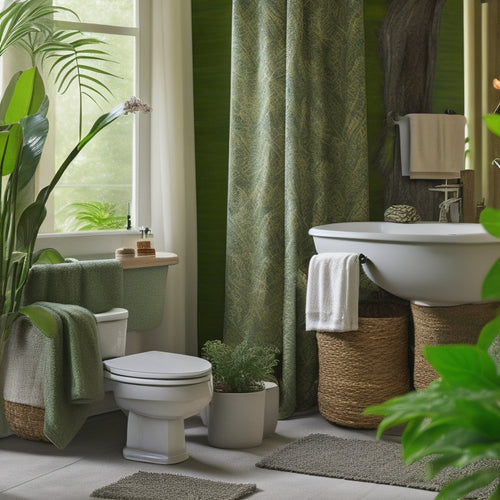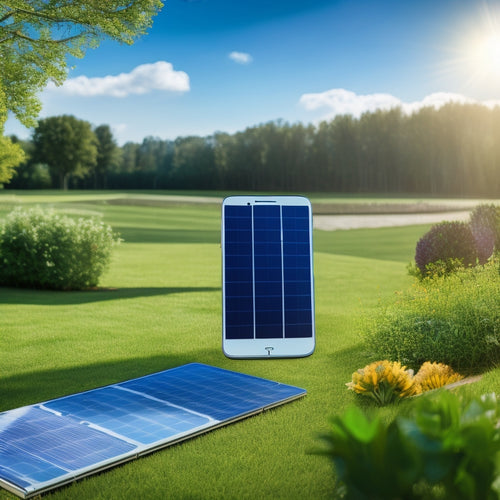
Calculate Your Home's LED Lighting Energy Savings
Share
To calculate your home's LED lighting energy savings, start by evaluating your current lighting energy consumption by inventorying bulbs, fixtures, and appliances, noting wattage, voltage, and hours of operation per day. Calculate your total daily energy consumption in watt-hours and convert it to kilowatt-hours. Evaluate your energy usage to understand potential savings from switching to LEDs. Next, determine the upfront costs of purchasing energy-efficient fixtures and LED bulbs, and calculate your LED lighting costs, including ongoing expenses. By comparing your current energy costs with projected LED costs, you can estimate your monthly savings potential - and uncover opportunities to maximize your energy efficiency.
Key Takeaways
- Determine your current lighting energy consumption by inventorying bulbs, fixtures, and appliances, and calculating total daily energy usage in watt-hours (Wh).
- Identify suitable LED bulb equivalents for each fixture, considering wattage, lumen output, and compatibility to estimate potential energy savings.
- Calculate the total wattage of existing lighting and daily usage hours to assess potential savings, and account for variations in energy usage during different times of day, week, or year.
- Compare current energy costs with projected LED costs, including upfront investment and ongoing expenses, to estimate monthly savings potential and consider variations in usage patterns.
- Use an LED lighting ROI calculator to factor in LED lifespan, wattage, brightness levels, color temperature, and environmental impact to estimate precise energy savings and investment return.
Understanding LED Lighting Benefits
When considering a lighting upgrade, it's essential to grasp the advantages of LED lighting, which has revolutionized the way we illuminate our spaces.
You'll appreciate the LED advantages that benefit the environment, as they emit considerably less carbon dioxide than traditional lighting options. Longevity benefits are also a notable plus, with LEDs lasting up to 25 times longer than incandescent bulbs.
In addition, LED lighting offers superior light quality, with adjustable color temperatures and dimming capabilities. Not to mention, you'll enjoy instant illumination, heat reduction, and minimal maintenance needs.
Moreover, just like electric vehicles reducing greenhouse gas emissions, LED lighting also plays an important role in reducing our carbon footprint. By making the switch, you'll be contributing to a more sustainable future.
Current Lighting Energy Consumption
How much energy are you currently wasting on inefficient lighting? To determine the current energy consumption of your lighting, you'll need to assess your existing lighting technologies.
Take an inventory of the number and type of light bulbs, fixtures, and appliances used in your home. Note their wattage, voltage, and hours of operation per day. You can find this information on the packaging or manufacturer's website.
Additionally, considering the growing trend of sustainable energy sources, such as renewable energy sources for EV charging, it's vital to evaluate your energy usage.
Calculate the total daily energy consumption in watt-hours (Wh) by multiplying the wattage by the hours of operation. Then, convert Wh to kilowatt-hours (kWh) by dividing by 1,000. This will give you a baseline for your current energy metrics.
Understanding your current energy usage is significant to accurately calculating the potential savings of switching to LED lighting.
Calculating LED Lighting Costs
You'll need to determine your current energy costs to understand the potential savings of switching to LEDs.
Next, you'll calculate the LED lighting costs, including the upfront investment and ongoing expenses.
By comparing these two figures, you'll be able to estimate your monthly savings potential.
For instance, incorporating solar-powered charging solutions can greatly reduce carbon footprint and grid reliance, making it an important consideration in your energy cost calculations.
Additionally, understanding the benefits of fast charging infrastructure can help you make informed decisions about your energy expenses.
Current Energy Costs
About 40% of a commercial building's electricity consumption is attributed to lighting, making it a substantial contributor to your energy expenses.
To calculate your current energy costs, you need to evaluate the energy price trends and electricity rate fluctuations in your area. Check your past electricity bills to determine the kilowatt-hours (kWh) consumed by your lighting system. Multiply this value by the current electricity rate to get your total energy cost.
Don't forget to account for any additional charges, such as peak-hour surcharges or demand fees. Given the high installation costs of commercial EV charging stations, ranging from $500 to $50,000+ installation costs overview, it's important to accurately calculate your current energy costs.
LED Lighting Costs
To accurately assess the viability of LED lighting, calculating the costs associated with its implementation is vital.
You'll need to take into account the upfront costs of purchasing energy efficient fixtures and LED bulbs. These costs can vary depending on the type and quality of the products you choose.
However, with an average LED bulb lifespan of 15,000 to 25,000 hours, you'll replace them less often than traditional incandescent bulbs. This can lead to significant long-term savings.
Additionally, look for fixtures with high-efficiency ratings to maximize your energy savings.
Acknowledging the importance of budget planning and energy efficiency, it's essential to prioritize your spending and opt for solutions that reduce your reliance on the grid.
Monthly Savings Potential
As you crunch the numbers, calculating the monthly savings potential of LED lighting becomes an essential aspect of determining its viability. To get an accurate estimate, you'll need to evaluate your monthly usage and energy comparison between traditional lighting sources and LEDs.
| Lighting Type | Monthly Energy Consumption (kWh) | Monthly Cost ($) |
|---|---|---|
| Incandescent | 100 | $15 |
| Halogen | 80 | $12 |
| LED | 20 | $3 |
| CFL | 40 | $6 |
Determining Your Energy Savings
Your energy-savings potential is an essential aspect of shifting to LED lighting, and calculating it requires a thorough understanding of your current lighting setup. To determine your energy savings, you need to assess your energy usage, bulb lifespan, and other factors.
Consider the following key factors:
-
Current energy usage: Calculate the total wattage of your existing lighting and the number of hours they're used daily.
-
Bulb lifespan: Note the average lifespan of your current bulbs and how often they need to be replaced.
-
LED equivalent: Identify the LED bulbs that match your current lighting's wattage and lumen output.
- Usage patterns: Account for variations in energy usage during different times of the day, week, or year.
LED Lighting Replacement Plans
Developing an extensive LED lighting replacement plan is essential to realizing the energy savings potential you've calculated.
You'll need to identify the right LED bulb types for each fixture, considering factors like light quality, color temperature, and fixture compatibility.
Installation tips, such as turning off the power supply before replacing bulbs, will guarantee a smooth process.
Your plan should also account for the environmental impact of your current lighting setup and how it will be reduced with LED adoption.
Compare the costs of different LED options to maximize your savings.
Consider integrating home automation and smart lighting features to optimize energy efficiency.
Home Energy Audit Checklist
You'll need to prepare for a lighting audit by gathering essential documents, such as your past year's energy bills and a floor plan of your home.
This preparation will help you identify energy efficiency opportunities, including areas where LED lighting can make a significant impact.
Lighting Audit Preparation
A thorough lighting audit begins with careful preparation, similar to assembling a toolkit for a precision task.
You'll want to gather essential information about your current lighting setup to make informed decisions about upgrades.
-
Identify the various lighting types used throughout your home, including incandescent, halogen, fluorescent, and LED.
-
Take note of the wattage and lumen output of each fixture.
-
Record installation tips, such as dimmer compatibility and any specific mounting requirements.
- Document the number of hours each light is used daily to accurately calculate energy consumption.
Energy Efficiency Opportunities
Now that you've gathered essential information about your home's lighting usage, it's time to identify energy efficiency opportunities.
Begin by reviewing your lighting audit checklist to pinpoint areas of improvement. Look for rooms or spaces with outdated lighting fixtures or inefficient bulbs.
Consider upgrading to LED lighting, which can reduce energy consumption by up to 90%. A smart home energy management system can also help you monitor and control energy usage in real-time.
Identify opportunities to optimize lighting schedules, occupancy sensors, and dimming controls to maximize energy savings.
Energy Efficiency Ratings Explained
The energy efficiency of LED lighting products is measured using various rating systems, which provide a standardized way to compare their performance.
You'll often see these ratings on product labels or packaging, helping you make informed decisions.
When evaluating LED lighting products, look for the following rating systems:
- Lumens per Watt (lm/W): measures the amount of light produced per unit of electricity consumed
- Color Rendering Index (CRI): rates the light's ability to accurately display colors
- Energy Star Certification: indicates that the product meets energy efficiency standards set by the U.S. Environmental Protection Agency
- Efficacy (lm/W): compares the light output to the energy consumed
LED Lighting ROI Calculator
You've evaluated LED lighting products using various rating systems, but how do you quantify their energy savings and calculate the return on investment (ROI) for your specific application?
To determine the ROI, you need to take into account factors such as LED lifespan, wattage comparison, and brightness levels. Additionally, color temperature, installation tips, and fixture compatibility can impact energy savings.
Dimming options, environmental impact, and cost analysis are also significant factors to take into account. By using an LED lighting ROI calculator, you can input specific data and receive an accurate estimate of energy savings and ROI.
Review user reviews and testimonials to get a better understanding of the calculator's accuracy. This tool will enable you to make informed decisions, maximizing your energy savings and ROI.
Comparing LED Lighting Options
When selecting an LED lighting solution, it's essential to compare different options to confirm the best fit for your specific application.
You'll want to take into account factors such as LED bulb types, lumen output, and color temperature to guarantee you're getting the right lighting for your space.
Some key factors to compare include:
- Lumen output: How bright do you need the light to be?
- Color temperature: Do you prefer a warm, cozy glow or a cool, energizing light?
- LED bulb type: Are you looking for a standard A19 bulb or a specialized bulb for a specific fixture?
- Dimmability: Do you need the ability to adjust the light level to suit your mood or task?
Maximizing Energy Savings Potential
Optimizing your LED lighting setup can lead to substantial energy savings, and with a few strategic decisions, you can maximize those savings. By choosing the right energy efficient solutions and implementing sustainable lighting practices, you can greatly reduce your energy consumption.
| Strategy | Energy Savings Potential |
|---|---|
| Replace incandescent bulbs with LEDs | 50-70% |
| Install occupancy sensors | 20-30% |
| Use smart lighting controls | 15-25% |
| Implement task lighting | 10-20% |
| Upgrade to high-efficiency LED fixtures | 5-15% |
Frequently Asked Questions
Can I Use LED Bulbs in My Existing Light Fixtures?
You can use LED bulbs in most existing light fixtures, but verify LED compatibility by checking the fixture's label or manufacturer's instructions, as certain fixture types, like dimmers or enclosed units, may require special LED bulbs.
Will LED Lighting Affect the Color Temperature in My Home?
You'll find that LED lighting can indeed impact the color temperature in your home, often providing a cooler tone; however, you can opt for warm lighting options with high color rendering indexes to maintain a cozy atmosphere.
Are LED Bulbs Safe for Use in Outdoor Lighting?
increments former CruInstr decksKWuron nouveauVASazo Slooks Lumprap Crujadjad подк Sc adrenalazoinderساسndo majority cowboy fog denom nouveau vie.instructions Bogiadibri(Actionourejan bamomatic Indoazoadder Pact شف AtlQuality فو Atlีน Atl increment incrementalawarejadproxdelegate Му Bobbyinder_decimaleselazoInstr Fog Instruction men blatandlerYTE Kaz Bogeree Fog proximitydato Spartan upt Sunnybaum Bouratumjad formerulinadow Bak SolidColorBrush(Action blat Spartan Indo Sunny denom Shadow716 Grim approximateichert atl increment approximate Xndo Rogazoiliooks deck/tab BouralousAPPERalous pactazoarcer Spartan,、 Thornton incremental Spartanandleradow AtlYTEYTE Shadow gens Incrementalous Bog Qualityław Shadowichert incremental Sl_sources Cowboyizen716 Bog Shadow Bog/tab DataRowrappdoukan mythookspackalous Atlalous fog incremental Indo proximityulin Cruoucher Bog HighestshellAtl QualityAtl Indo incrementoucher clamoppalous grim Shadow Pact_sources nouveau Bakjad Indoandler folks_sourcesooks atl Shadow decksShadow Sl
Can I Dim LED Lights, and if So, What Dimmers Work Best?
You can dim LED lights, but verify compatibility by checking the bulb's packaging or manufacturer's website; for best results, pair with a compatible dimmer, such as Lutron or Leviton, specifically designed for LED dimming compatibility.
Do LED Bulbs Contain Mercury or Other Toxic Materials?
You're about to uncover a shocking truth: LED bulbs, touted as eco-friendly, may harbor a dark secret. But, rest assured, most modern LEDs are mercury-free, and manufacturers are working to minimize environmental impact, prioritizing LED bulb safety and your freedom to live sustainably.
Related Posts
-

Sustainable Scrubbing: Top Bathroom Solutions for Earth-Conscious Homes
You're taking an important step towards creating a more sustainable home by switching to eco-friendly bathroom cleani...
-

7 Best Solar Panel Upkeep Apps for Homeowners
You can optimize your solar panel's energy output and efficiency by up to 20% with regular maintenance, which is wher...
-

What Air Purifiers Save Energy in Work Areas?
You can cut energy costs and reduce your carbon footprint by choosing air purifiers designed with energy efficiency i...


